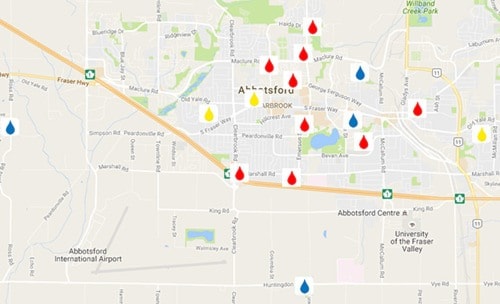The Abbotsford School District has a plan to deal with elevated levels of lead in some of its schools' drinking water.
In early September, it was revealed that testing had found higher-than-acceptable lead levels in drinking water at 21 of the 36 district sites (mostly schools, but also including other district buildings) built before 1990. The lead is believed to come from solder on some links of water pipes but there are no actual lead pipes, according to district officials.
Those 21 sites implemented interim measures to mitigate the risk of lead exposure of students and staff. School staff were told to run taps for two minutes every morning to flush out stagnant water with higher levels of lead in them. At schools where lead levels remained high after flushing, the drinking fountains were shut down and have been replaced with water coolers.
Since then, a consulting group has conducted further testing and has put those same 36 schools into three categories to determine if lead levels were above or below the guideline limit of .01 milligrams per litre before and after flushing.
A kitchen sink in the Abbotsford Virtual School building exceeded the guidelines by more than 30 times, with .339 mg/L, the most-concentrated amount of lead found at any district site.
Full results for all sources tested can be found below.
The sites were then put in three categories: A, B and C.
Sites in Group A have safe drinking water throughout and require not further consideration.
Group B sites had water tested as safe close to their supply but had elevated lead levels near pipe branch lines and at fixtures. These schools will have pipe branch lines replaced, as well as new fountains, taps and the installation of new bottle-filling stations.
Group B sites: Aberdeen (one of four sources failed test pre-flush); Mt. Lehman (two of four sources failed pre-flush); school board office (two of three sources failed pre-flush); Ten Broeck (three of four sources failed), Terry Fox (two of four sources failed); W. A. Fraser (one of six sources failed).
And Group C schools failed tests at the main supply. These schools will require the replacement of pipes and components from the source of entry to the school to the closest area where tests failed, as well as the replacement of fountains and taps.
Group C sites: Abby Arts Centre; Abby Virtual; Aboriginal Centre; Bakerview; Centennial Park; Chief Dan George; John MacLure; North Poplar; Upper Sumas; W. J. Mouat.
The district plans to finish the repairs by March 31, 2017.
The Ministry of Education has approved $840,000 in funding for the project.
Several schools in Prince Rupert were also found to have levels of lead higher than regulations allow earlier this year. That district opted to install individual drinking fountains with filtration systems for lead.
Abbotsford School District secretary treasurer Ray Velestuk said filtration is a less-permanent solution to the problem and won't likely be the primary strategy in Abbotsford.
Abbotsford Schools Drinking Water Investigation by Kelvin Gawley on Scribd
